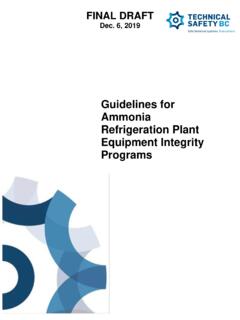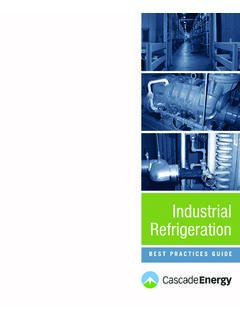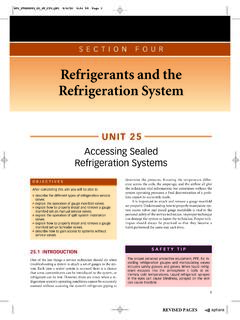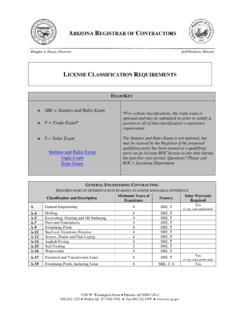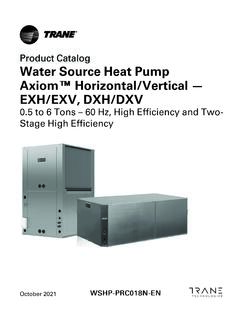Transcription of Maintenance of refrigeration equipment
1 ` WHO Vaccine Maintenance of refrigeration equipment Technical supplement to WHO Technical Report Series, No. 961, 2011 Annex 9: Model guidance for the storage and transport of time and temperature sensitive pharmaceutical products January 2014 World Health Organization 2014 WHO Press, World Health Organization, 20 Avenue Appia, 1211 Geneva 27, Switzerland (tel.: +41 22 791 3264; fax: +41 22 791 4857; e-mail: Requests for permission to reproduce or translate WHO publications whether for sale or for noncommercial distribution should be addressed to WHO Press, at the above address (fax: +41 22 791 4806; e-mail: The designations employed and the presentation of the material in this publication do not imply the expression of any opinion whatsoever on the part of the World Health Organization concerning the legal status of any country, territory, city or area or of its authorities, or concerning the delimitation of its frontiers or boundaries.))
2 Dotted lines on maps represent approximate border lines for which there may not yet be full agreement. The mention of specific companies or of certain manufacturers products does not imply that they are endorsed or recommended by the World Health Organization in preference to others of a similar nature that are not mentioned. Errors and omissions excepted, the names of proprietary products are distinguished by initial capital letters. All reasonable precautions have been taken by the World Health Organization to verify the information contained in this publication. However, the published material is being distributed without warranty of any kind, either expressed or implied. The responsibility for the interpretation and use of the material lies with the reader.
3 In no event shall the World Health Organization be liable for damages arising from its use. The named authors alone are responsible for the views expressed in this publication. Technical Supplement: Maintenance of refrigeration equipment 2 Acknowledgments The author of this document is Richard Lawton, Technical Director, Cambridge refrigeration Technology, Cambridge, UK. Technical Supplement: Maintenance of refrigeration equipment 3 Contents Acknowledgments .. 2 Contents .. 3 Abbreviations .. 5 Glossary .. 6 1. Introduction .. 8 Requirements .. 8 8 Target readership .. 8 2. Guidance .. 9 Associated materials and equipment .. 9 Active and passive transport containers .. 9 Refrigerators and freezers.
4 10 Freezer rooms, cold rooms and controlled ambient stores .. 11 Maintenance overview .. 11 Maintaining the cooling system .. 12 Maintaining insulated panels and vapour control sealing .. 12 Condensation control outside the cold store enclosure .. 14 Frost-heave control: .. 15 Cold store panel insulation: .. 15 Insulation for refrigeration pipes and other penetrations: .. 15 Cold store Maintenance schedule .. 16 Refrigerated vehicles .. 16 Refrigerated vans .. 17 Refrigerated rigid bodies .. 17 Refrigerated semi-trailer .. 17 Refrigerated containers .. 18 Decommissioning .. 19 Staff training .. 19 References .. 20 Annex 1 - Checking refrigerated vehicles .. 21 - Checking insulation on a refrigerated vehicle.
5 21 Technical Supplement: Maintenance of refrigeration equipment 4 - Checking cooling equipment on a refrigerated van .. 21 - Checking cooling equipment on a rigid vehicle or semi- trailer .. 22 Revision history .. 23 Technical Supplement: Maintenance of refrigeration equipment 5 Abbreviations CAPA Corrective and Preventive Action (procedures) ASHRAE American Society of Heating, Refrigerating & Air-Conditioning Engineers ATP Agreement on the International Carriage of Perishable Foodstuffs and on the Special equipment to be Used for such Carriage: - UNECE BSEN British Standard European Norm CFC Chlorofluorocarbons GRP Glass reinforced plastic GWP Global Warming Potential HC Hydrocarbon HCFC Hydrochlorofluorocarbons ODP Ozone Depletion Potential SOP Standard Operating Procedure TTSPP Time and Temperature-Sensitive Pharmaceutical Product UNECE The United Nations Economic Commission for Europe (UNECE or ECE) UNEP The United Nations Environment Programme (UNEP) Technical Supplement: Maintenance of refrigeration equipment 6 Glossary Active systems.
6 Actively powered systems using electricity or other fuel source to maintain a temperature-controlled environment inside an insulated enclosure under thermostatic regulation ( cold rooms, refrigerators, temperature-controlled trucks, refrigerated ocean and air containers). Passive systems: Systems which maintain a temperature-controlled environment inside an insulated enclosure, with or without thermostatic regulation, using a finite amount of pre-conditioned coolant in the form of chilled or frozen gel packs, phase change materials, dry ice or others. Pharmaceutical product: Any product intended for human use or veterinary product intended for administration to food producing animals, presented in its finished dosage form, that is subject to control by pharmaceutical legislation in either the exporting or the importing state and includes products for which a prescription is required, products which may be sold to patients without a prescription, biologicals and vaccines.
7 It does not, however, include medical devices1. refrigeration equipment : The term refrigeration or refrigeration equipment means any equipment whose purpose is to lower air and product temperatures and/or to control relative humidity. Service Level Agreement (SLA): A service level agreement or contract is a negotiated agreement between the customer and service provider that defines the common understanding about materials or service quality specifications, responsibilities, guarantees and communication mechanisms. It can either be legally binding, or an information agreement. The SLA may also specify the target and minimum level performance, operation or other service attributes2. Standard Operating Procedure (SOP): A set of instructions having the force of a directive, covering those features of operations that lend themselves to a definite or standardized procedure without loss of effectiveness.
8 Standard operating policies and procedures can be effective catalysts to drive performance improvement and improve organizational results. Third Party Accreditation: Accreditation or certification by an organization that issues credentials or certifies third parties against official standards as a means of establishing that a contractor is competent to undertake a specific type of work. Third party accreditation organizations are themselves formally accredited by accreditation bodies; hence they are sometimes known as "accredited certification bodies". The accreditation process ensures that their certification practices are acceptable, typically meaning that they are competent to test and certify third parties, behave ethically and employ suitable quality assurance.
9 1 Definition from WHO/ Rev 1 Sept 2009. Proposal for revision of WHO good distribution practices for pharmaceutical products Draft for comments. 2 Definition from IATA, Chapter 17, 9th Edition, June 2009. Technical Supplement: Maintenance of refrigeration equipment 7 Time and temperature sensitive pharmaceutical product (TTSPP): Any pharmaceutical good or product which, when not stored or transported within pre-defined environmental conditions and/or within pre-defined time limits, is degraded to the extent that it no longer performs as originally intended. Technical Supplement: Maintenance of refrigeration equipment 8 1. Introduction This technical supplement has been written to amplify the recommendations on preventive Maintenance given in WHO Technical Report Series No.
10 961, 2011, Annex 9: Model guidance for the storage and transport of time- and temperature-sensitive pharmaceutical products3. It does not specifically deal with emergency Maintenance or contingency planning. Related topics are covered in the companion Technical Supplement Maintenance of storage facilities. Requirements Implement a Maintenance programme for all temperature-controlled rooms, cold rooms, freezer rooms, refrigerators and freezers: Carry out regular preventive Maintenance on all temperature controlling equipment . Employ best practice to eliminate leakage of refrigerant into the environment during installation, Maintenance and decommissioning of refrigeration equipment . Records should be maintained to demonstrate compliance with the above requirements.










